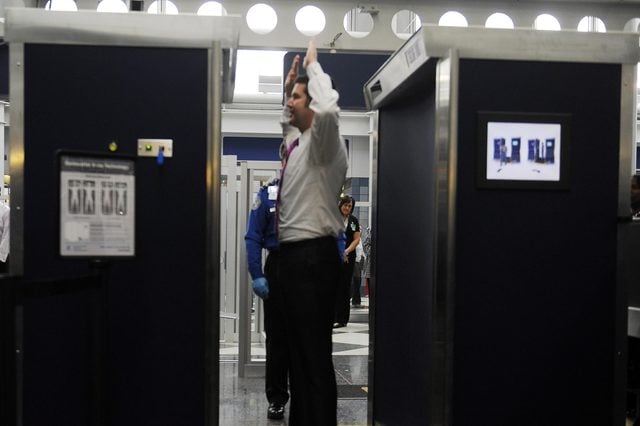This Is What You Need to Know About Those Full-Body Airport Security Scanners
Updated: Nov. 04, 2020
If every time you step into a full body security scanner at the airport you think, "I must be getting cancer!" you're not alone. We got a medical expert to tell us whether or not we should be worried.
 Getting through security is the worst part of flying. And now there’s the full-body airport security scanners—do they pose a threat to your health? It depends on the frequency with which you’re exposed to them. “If you fly two or three times a year, then the scanner most likely won’t have an impact on your health,” says Robert Boxer, MD, a medical specialist and author of Sane Driving in a Mad World: Driving Safety, Courtesy, and Responsibility. “If you’re stepping into the full-body scanner two or three times a day, then you should probably be more prudent.”
Getting through security is the worst part of flying. And now there’s the full-body airport security scanners—do they pose a threat to your health? It depends on the frequency with which you’re exposed to them. “If you fly two or three times a year, then the scanner most likely won’t have an impact on your health,” says Robert Boxer, MD, a medical specialist and author of Sane Driving in a Mad World: Driving Safety, Courtesy, and Responsibility. “If you’re stepping into the full-body scanner two or three times a day, then you should probably be more prudent.”
Here’s what you need to know.
Radiation is a known carcinogen. Studies from the aftermath of large scale radiation exposures (atomic bombs and nuclear accidents) showed an increased risk of cancer. “These were exposures with large doses of radiation,” explains Mark Terris, MD, an otolaryngology-head and neck surgeon and author of Bullets to Bandages: Life Inside the Israel Defense Forces. “Fortunately, airport scanners emit a very low dose of radiation, so it does not pose a significant health risk. It is estimated that we are exposed to the same dose of radiation every three to nine minutes of daily living,” he adds.
Believe it or not, when you fly 30,000 feet, you’re exposed to the same amount of radiation that you would be exposed to during a chest X-ray. Electromagnetic fields are also emitted by cell phones, ovens, radios, and basically anything you plug in. “So if there is an electromagnetic field, then you’re getting exposed to some level of radiation,” says Dr. Boxer.
Airport scanners emit ionizing radiation, which is the same type of radiation that is emitted from other forms of medical imaging (X-ray and CT scans), though at a much lower dose. “This form of radiation will damage cells at high doses,” says Dr. Terris.
The scanner will expose pregnant women to some level of radiation, so they should be manually patted down instead. “When I was younger and completing my medical internship, I avoided giving X-rays to pregnant women in all instances,” says Dr. Boxer. The number one rule in medicine is “do no harm.” Exposing a pregnant woman to X-rays and radiation can lead to fetal and developmental abnormalities.
Cardiac problems can also occur and will affect the way the body is developing, particularly during the first three months of pregnancy. “Women who think they may be pregnant, shouldn’t use the scanner. If you’re not 100 percent certain you’re not pregnant, you shouldn’t take the risk. So if you think there’s a chance, just choose the manual pat down,” says Dr. Boxer.
Full-body airport security scanners generally have less radiation than the X-ray machines used medically. But remember: “It’s all about frequency. If you’re flying constantly, it’s better to be cautious and just have the manual pat down,” says Dr. Boxer.
“If you could be exposed three or four times a day to the full-body scanner, then prudent avoidance is a good idea,” says Dr. Boxer. If you know you’re going to fly multiple times in one day, ask for a pat down. Don’t go through the scanner each time.
Disclosure: This post is brought to you by Reader’s Digest editors, who aim to highlight products and services you might find interesting. If you buy them, we may get a small share of revenue from our partners, such as Amazon Services LLC Associates Program. We frequently receive products free of charge from manufacturers to test. This does not drive our decision as to whether or not a product is featured or recommended. We welcome your feedback. Have something you think we should know about? Email us at [email protected]